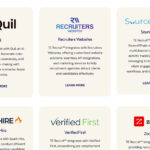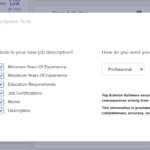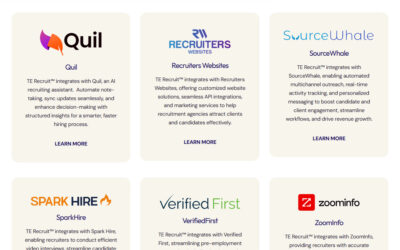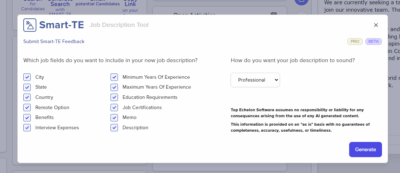Intake meetings are a critical yet often overlooked component of the recruiting process. While they are obligatory, they can sometimes feel like little more than a formality—both you and the client may find yourselves yawning through a checklist of mundane questions about dates, compensation, and candidate expectations. The conversation may end with both parties unsure of the next steps, leaving a sense of dissatisfaction and missed opportunities.
But what if intake meetings could be transformed into a strategic tool for success, both for you and your client? What if they could help you improve your recruiting process, strengthen relationships, and enhance your credibility as a recruiter? With the right approach, intake meetings can be much more than a tedious necessity—they can be the competitive edge that sets you apart from other recruiters.
In this article from Top Echelon Recruiting Software, we will explore how to prepare for and execute intake meetings in a way that goes beyond merely ticking boxes. We’ll cover how to use these meetings to decrease miscommunication, enhance your reputation as a recruiter, and build lasting relationships with your clients. By mastering the art of intake meetings, you can ensure a more efficient hiring process and ultimately, better placements.
The Importance of Intake Meetings
At its core, an intake meeting is a conversation that helps you understand the requirements and expectations for a position. But when done right, it can serve several additional purposes:
- Decrease miscommunication: A well-executed intake meeting helps clarify the client’s needs and ensures that both parties are aligned from the outset, reducing the need for follow-up conversations and misunderstandings later.
- Increase your credibility: When you come to the meeting prepared and ask insightful questions, you demonstrate your expertise, professionalism, and attention to detail, boosting your credibility with the client.
- Build and nurture client relationships: Intake meetings are an opportunity to build rapport with your clients. By leading the conversation and guiding them through the process, you can establish trust and strengthen the relationship.
Rather than approaching an intake meeting as a checklist to fill out, think of it as an opportunity to have a strategic conversation about your client’s hiring needs. Often, clients are unclear about exactly what they’re looking for, or they struggle to articulate their requirements. It’s your job to help them define those needs and set realistic expectations.
How to Prepare for an Effective Intake Meeting
Preparation is the foundation of a successful intake meeting. The more prepared you are, the better the conversation will flow, and the more value you’ll provide to your client. Here’s how to set yourself up for success:
1. Research the Market and the Role
Before the meeting, gather as much information as possible about the position and the industry. This will enable you to ask the right questions and demonstrate your expertise during the conversation. Here are some things to research:
- Market salary: Understand the going rate for the position you’re recruiting for in the client’s geographic area and industry. This allows you to have informed discussions about compensation and manage expectations.
- Skills and qualifications: Look up typical skills, certifications, and qualifications required for the role. Review LinkedIn profiles of professionals with the same job title to get a sense of the current talent pool.
- Industry trends: Research what other companies are doing to fill similar roles. This information can be useful if your client is unsure about job requirements or is struggling to attract the right candidates.
- Client history: If you’ve worked with this client before, review previous hires. Were there any bottlenecks or issues in past projects? What made those placements successful (or not)? Use this information to refine your process and address potential challenges upfront.
- Candidate profiles: If you’ve placed candidates in similar roles before, revisit their profiles. Consider past instances where candidates didn’t meet all the requirements but still proved to be great hires. This can help you manage client expectations and emphasize the importance of flexibility in hiring criteria.
2. Set the Tone for the Meeting
It’s important to frame the intake meeting as a strategic discussion, rather than a simple form-filling exercise. Let the hiring intake form be a tool, not the focus. Approach the meeting as a collaborative effort to solve a problem—the problem of finding the best candidate for the role. This mindset will elevate the conversation and increase the likelihood that the client will invest in the process.
How to Execute a Strategic Intake Meeting
Once you’ve prepared thoroughly, it’s time to execute the intake meeting. The key to success is asking thoughtful, analytical questions that help the client define their needs, while also positioning yourself as a strategic partner in their hiring process.
1. Ask Analytical and Probing Questions
A checklist of basic questions won’t cut it if you want to stand out as a recruiter. Instead, ask open-ended questions that encourage the client to think critically about the role, the team, and the company culture. Here’s a guide to the types of questions you should ask:
- Question: What does the position entail?
- Follow-ups: Why is this position open? What makes this position critical to the company? What do you expect from a new hire within the first 90 days?
- Question: What department will the position be in?
- Follow-ups: What does the team look like now? How does the team interact with the new hire? Who will the new hire report to, and how will they communicate with other team members?
- Question: What skills and experience are necessary for this position?
- Follow-ups: What would make you decline a candidate immediately? Are there any “nice-to-have” skills that aren’t deal-breakers? Could the right candidate grow into the role, or do they need to hit the ground running?
- Question: What is the compensation structure?
- Follow-ups: Why do people like working at this company? What opportunities for growth and development can you offer candidates?
By asking probing follow-up questions, you’ll not only gather more information, but you’ll also help the client articulate the intangibles that they may not have considered. These deeper insights give you a more complete picture of what they’re looking for, allowing you to find a candidate who is a true fit for both the role and the company culture.
2. Set and Manage Expectations
As a recruiter, you bring valuable expertise and experience to the table. Part of your role is to help clients set realistic expectations for the hiring process. Use the intake meeting as an opportunity to educate the client about how the process works, what to expect, and how long it might take to find the right candidate.
Here are some topics to cover:
- Pipeline metrics: How many candidates will likely make it through each stage of the pipeline (applications, screenings, interviews)?
- Time-to-hire: Provide an estimated timeline for when the position is likely to be filled. Be honest about potential delays, especially if the role is highly specialized.
- Costs: Discuss the expected costs associated with the search, including the resources required to find top candidates.
- Sourcing plan: Share your strategy for sourcing candidates. Which channels will you use—job boards, networking, LinkedIn, or other methods? Be transparent about your approach to reassure the client.
- Check-in schedule: Set expectations for how often you’ll check in with the client to provide updates and discuss progress. Regular touchpoints can help keep the client engaged and prevent misunderstandings.
Consider putting together a one-page document that outlines your process and expectations. This not only adds a layer of professionalism but also reinforces the idea that you’ve honed your recruiting practice to a science. Clients will appreciate the transparency and feel more confident in your ability to deliver results.
3. Get the Client’s Commitment
It’s crucial to inspire a sense of urgency in the hiring manager. Talent is scarce, and the best candidates won’t wait around for long. Encourage the client to act quickly once the right candidate is found, and emphasize the importance of a streamlined recruiting process to ensure a positive candidate experience.
One way to ensure the process moves swiftly is to set clear guidelines for response times. For example, agree on a 24-48 hour response window for feedback on candidates or interview scheduling. This helps keep the process moving and prevents candidates from losing interest or receiving offers from other companies.
Additionally, setting up weekly check-ins can keep communication consistent and ensure both parties stay aligned throughout the process.
Leveraging Intake Meetings for Long-Term Success
When executed thoughtfully, intake meetings can be more than just a formality—they can be a powerful tool for building relationships and setting yourself apart from other recruiters. Here’s how to leverage intake meetings for long-term success:
1. Build Trust and Rapport
Intake meetings are a chance to showcase your professionalism and expertise. By asking insightful questions, managing expectations, and demonstrating your process, you can build trust with the client. The more invested they feel in the relationship, the more likely they are to return to you for future hiring needs.
2. Foster a Collaborative Relationship
Position yourself as a partner, not just a service provider. Intake meetings allow you to collaborate with the client, rather than simply taking orders. By working together to define the ideal candidate, you can ensure a more successful hiring outcome.
3. Keep Clients Coming Back
Satisfied clients will come back to you for future hires. When you make intake meetings a strategic part of the hiring process, clients will appreciate the value you bring to the table. A successful placement resulting from a thorough intake meeting strengthens the client relationship and increases the likelihood of repeat business.
Conclusion: Turning Intake Meetings into a Strategic Advantage
Intake meetings are an essential part of the recruiting process, but they don’t have to be mundane or perfunctory. By preparing thoroughly, asking the right questions, and positioning yourself as a strategic partner, you can transform these meetings into a powerful tool for success. With the right approach, intake meetings can help you improve communication, set realistic expectations, and build strong, long-lasting relationships with your clients.
The next time you schedule an intake meeting, don’t treat it as just another item on your to-do list. Instead, see it as an opportunity to showcase your expertise, deepen your relationship with the client, and lay the foundation for a successful hiring process. The more value you bring to the intake meeting, the more value you’ll get in return—both in terms of successful placements and ongoing business relationships.








